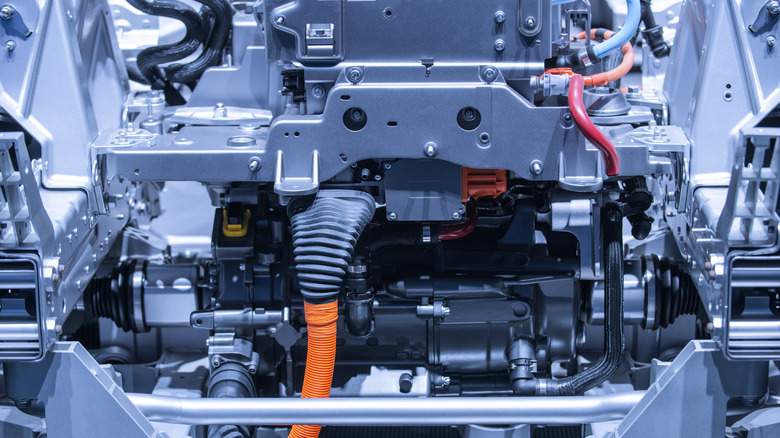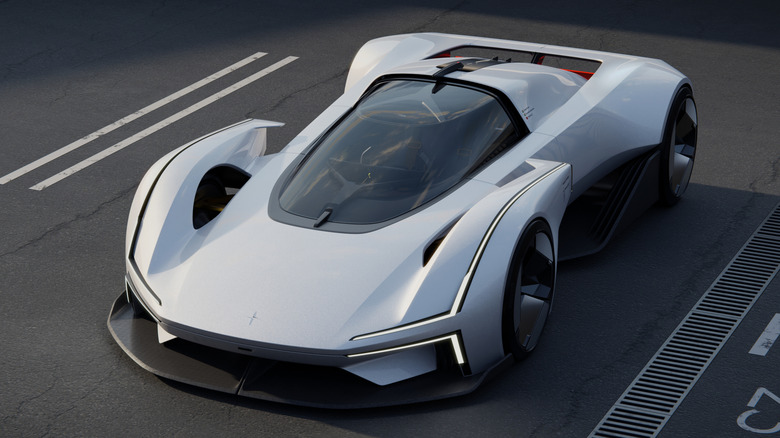How Does An Electric Vehicle's Powertrain Impact The Car's Range?
The way that an electric vehicle's (EV) powertrain impacts the car's range is related to several different factors. One is the size of the battery in your EV. All else being equal, a larger battery with a higher kWh rating gives you more range. A larger capacity battery has more stored energy in it, letting you go farther on a charge compared to a smaller battery. If you think of your battery as similar to the gas tank in an internal combustion engine (ICE) vehicle, a larger battery, like a larger gas tank, will let you go farther.
Another powertrain factor that impacts an EV's range is the power consumption of its electric motor or motors, if there is more than one. Driven in a similar manner, a single-engine, two-wheel drive EV will have more range than a dual-motor all-wheel drive (AWD) EV, assuming they both have the same size battery. This is also due to the single motor system's lower weight and higher efficiency, which eliminates the weight and the added power consumption of a second motor.
One more factor of your EV powertrain that affects its range is the size of its wheels. Generally speaking, smaller diameter wheels will produce higher range figures, compared to larger diameter wheels. This is because smaller wheels and tires tend to weigh less, which means that less energy is required to get them moving. This directly translates to greater range in an EV. These factors are the primary contributors to 5 EVs with the worst range (and 5 with the best).
What other factors can impact an EV's range?
There are several other factors that can affect the range of an EV and have nothing to do with the drivetrain. A major one is the aerodynamics of the EV you are driving. The aerodynamic drag of a typical EV can be responsible for as much as 50% of its energy consumption at highway speeds. Since EVs are usually more efficient in the city than on the highway, thanks to their increased use of regenerative braking in city settings, a more aerodynamic EV with less drag should provide increased range on the highway, all other things being equal.
Extreme temperatures by themselves can affect your EV range. Add to that, much you use your heating and air conditioning systems also have an impact. Because these systems consume energy from your battery whenever you use them, they can reduce your ultimate range. If the outside temperature is extremely cold or very hot, the power drain from these systems can reduce your range significantly. One way to minimize some of the effects of the power drain from using the heating and air conditioning systems is to precondition your interior. This involves cooling down or warming up the inside of your car while it is still connected to the charger, thus bypassing your EV's battery. Another energy-saving strategy is to use your EV's heated seats instead of the heater.
How does your driving style affect an EV's range?
The way that you drive an EV will also affect its range, for both better and worse. While hard acceleration in an EV will impress your passengers, it also consumes extra energy from your battery, reducing your range. Hard braking should also be avoided, as this may overtax your regenerative braking system and cause the non-regenerative friction brakes to engage, wasting your braking energy and turning it into heat.
Where you drive your EV also affects its range. Since EVs achieve their highest efficiency at both lower speeds and in city settings (where aero drag is low and brake regen use is high), you will tend to get more range in this type of driving. If it is possible to keep your EV's speed below 50 mph and drive exclusively on city streets, you will get the longest range possible. Of course, this may not be possible on longer trips, where time is a consideration.
Another factor that both EV and ICE drivers need to be aware of is maintaining the proper inflation pressures in their tires. This is a particularly sensitive issue for EVs, which tend to be heavier than their ICE counterparts, thanks to their large batteries. Underinflation can lead to increased wear on the outside edges of your tires, increased heat levels within your tires, poorer steering and handling performance, and higher rolling resistance, which will reduce your EV's range.


